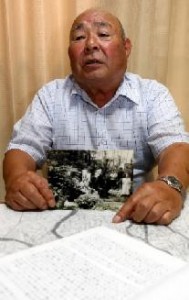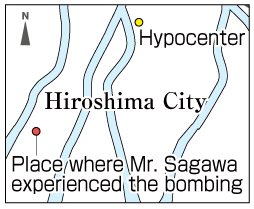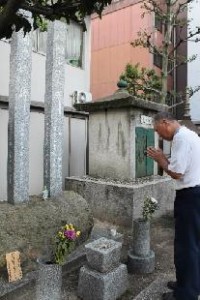Osamu Sagawa, 73, Higashi Ward, Hiroshima
Sep. 14, 2012
Vivid memory of his mother, burned by the bomb
Though blinded, she returned to her family
Osamu Sagawa, 73, was 6 years old when the atomic bomb was dropped on Hiroshima. His mother, Masako, 38 at the time, died from her wounds. “I wanted to cling to her, but she was in no condition to hold me,” Mr. Sagawa said, vividly recalling the scene on August 6, 1945. “Her injuries were terrible.” Mr. Sagawa’s mother returned home with burns covering her body.
Back then, Mr. Sagawa was a first-grader at Funairi National School (now, Funairi Elementary School) and he was at the school, located just over 2 kilometers from the hypocenter, at the time of the bombing. He was listening to the vice principal speak in the schoolyard when he looked up at the sky and spotted an airplane. Then they were hit by a powerful flash and a teacher shouted, “Take cover!” Mr. Sagawa quickly went face down on the ground.
Luckily, he wasn’t injured, and after attendance was taken, he went home in tears. His eldest sister and younger sister were still at home and were crying, waiting for the rest of the family to return.
That morning Mr. Sagawa’s mother had left the house to help dismantle buildings in the Zakoba district, near the hypocenter, to create a firebreak in the event of air raids. Though his father was running a company that produced needles in Shanghai, China, he had returned home for a visit and went to the Yokogawa area early that morning.
Mr. Sagawa was outside their house, waiting with his sisters, when his mother came home. Her clothes were scorched and shredded, leaving only her belt in place. Her body was burned black and the skin dangled down from both hands. Her scalp and her hair were drooping from her forehead.
She was barely able to communicate to her children, telling them that, because she couldn’t see, she asked the people around her for directions and finally managed to reach their house.
Mr. Sagawa’s father returned home some time later and took his mother to receive first aid. The only treatment available amid the chaos, though, was oil, which was dabbed over her burned body. Because their house was razed by fire, the family was forced to spend the next few weeks at the house of his father’s friend who lived nearby.
Maggots festered in his mother’s wounds, and Mr. Sagawa helped to remove them with chopsticks. She smiled at him, and thanked him, but passed away on August 12.
That fall, his father built a shack on the site where their house had once stood. The following year, 1946, his father resumed his duties at the needle factory and took over the responsibility of raising his children.
Later in life, Mr. Sagawa got married and had two daughters, then became a grandfather of four grandchildren. A few years ago, he suffered a cerebral infarction and a heart attack. Thinking his last chance had come, in September 2011 he made a written account of his A-bomb experience, for the first time, in order to hand down his memories to his grandchildren.
“We should never wage war again,” he said, sharing his wishes for today’s young people. “I hope, as a first step, that the children of the world will communicate with each other and build trust between them.” (Sakiko Masuda, Staff Writer)
Many helping to create a firebreak died
The Zakoba district, once located in the city center, covered part of today’s Kokutaiji district and the Komachi district of Naka Ward. The Zakoba district was in existence until 1965, when Hiroshima’s address system underwent a change.
When the atomic bomb was dropped, Hiroshima City Hall was located on the western side of the Zakoba district. City Hall played an important role in responding to air raids, such as issuing evacuation orders and implementing relief efforts. To help prevent fires caused by air raids from spreading, the idea of firebreaks was pursued, in which certain buildings in crowded areas were designated for demolition.
Many people who had been mobilized for this work, from neighborhoods, work places, and schools, died in the atomic bombing that day. According to a special exhibition held at Hiroshima Peace Memorial Museum in 2004, roughly 75% of the 2331 mobilized students--1749 students from 12 schools, including national schools and junior high schools--were killed. In the area known as Kokutaiji 1-chome are found a memorial to the memory of female students and others who became victims of the blast and a monument which indicates the site of the demolition work. The neighborhood association there organizes a memorial service every August 6. “A lot of people died around here,” said Kyoko Kitani, 88, who was born in the Zakoba district and faithfully tidies up around the monuments. “We can’t forget that fact.”
Teenagers’ Impressions
I was moved by the story of his mother
I was moved by the story Mr. Sagawa told us about his mother, who was burned and blinded, but with all her might, made it home to her family. “It was because my mother took on all that suffering that we were hardly injured ourselves,” he said. It made me think again that atomic bombs, which can deprive us of loved ones in an instant, should be banned. (Kanna Inoue, 16)
I want to be strong like him
I was most impressed by his words: “It’s pointless for nations to hate one another. The important thing is for us to trust each other and get along together.” If everyone in the world thought like this, then we could make a peaceful world. The atomic bomb changed Mr. Sagawa’s life and stole away his mother, but he has continued to live strongly to this day. I’d like to learn to be strong, like him, to overcome my own hardships. (Kana Kumagai, 17)
Staff Writer’s Notebook
On August 5, 1945, one day before the atomic bomb was dropped, Mr. Sagawa’s family visited Fukugimura (now part of Higashi Ward) to meet his second eldest brother and two elder sisters who had evacuated there in a school group. His brother and sisters joined the other schoolchildren in singing and dancing for the visitors that day. It never occurred to them that this would be their final opportunity to gather as a family.
The next morning, Mr. Sagawa’s mother took a neighbor’s place and went out to help dismantle buildings to create a firebreak in the event of air raids. When the clock struck 8:15 that morning and the atomic bomb exploded, she was only about 1 kilometer from the hypocenter.
Although she was blinded, and her whole body was burned, she summoned all her strength and made it back home. When she arrived, she was crying and shouting “Osamu!” and her other children’s names. The thought of his mother’s determination and deep love left me speechless. (Sakiko Masuda, Staff Writer)
(Originally published on August 27, 2012)
Though blinded, she returned to her family
Osamu Sagawa, 73, was 6 years old when the atomic bomb was dropped on Hiroshima. His mother, Masako, 38 at the time, died from her wounds. “I wanted to cling to her, but she was in no condition to hold me,” Mr. Sagawa said, vividly recalling the scene on August 6, 1945. “Her injuries were terrible.” Mr. Sagawa’s mother returned home with burns covering her body.
Back then, Mr. Sagawa was a first-grader at Funairi National School (now, Funairi Elementary School) and he was at the school, located just over 2 kilometers from the hypocenter, at the time of the bombing. He was listening to the vice principal speak in the schoolyard when he looked up at the sky and spotted an airplane. Then they were hit by a powerful flash and a teacher shouted, “Take cover!” Mr. Sagawa quickly went face down on the ground.
Luckily, he wasn’t injured, and after attendance was taken, he went home in tears. His eldest sister and younger sister were still at home and were crying, waiting for the rest of the family to return.
That morning Mr. Sagawa’s mother had left the house to help dismantle buildings in the Zakoba district, near the hypocenter, to create a firebreak in the event of air raids. Though his father was running a company that produced needles in Shanghai, China, he had returned home for a visit and went to the Yokogawa area early that morning.
Mr. Sagawa was outside their house, waiting with his sisters, when his mother came home. Her clothes were scorched and shredded, leaving only her belt in place. Her body was burned black and the skin dangled down from both hands. Her scalp and her hair were drooping from her forehead.
She was barely able to communicate to her children, telling them that, because she couldn’t see, she asked the people around her for directions and finally managed to reach their house.
Mr. Sagawa’s father returned home some time later and took his mother to receive first aid. The only treatment available amid the chaos, though, was oil, which was dabbed over her burned body. Because their house was razed by fire, the family was forced to spend the next few weeks at the house of his father’s friend who lived nearby.
Maggots festered in his mother’s wounds, and Mr. Sagawa helped to remove them with chopsticks. She smiled at him, and thanked him, but passed away on August 12.
That fall, his father built a shack on the site where their house had once stood. The following year, 1946, his father resumed his duties at the needle factory and took over the responsibility of raising his children.
Later in life, Mr. Sagawa got married and had two daughters, then became a grandfather of four grandchildren. A few years ago, he suffered a cerebral infarction and a heart attack. Thinking his last chance had come, in September 2011 he made a written account of his A-bomb experience, for the first time, in order to hand down his memories to his grandchildren.
“We should never wage war again,” he said, sharing his wishes for today’s young people. “I hope, as a first step, that the children of the world will communicate with each other and build trust between them.” (Sakiko Masuda, Staff Writer)
Hiroshima Insight: The Zakoba district
Many helping to create a firebreak died
The Zakoba district, once located in the city center, covered part of today’s Kokutaiji district and the Komachi district of Naka Ward. The Zakoba district was in existence until 1965, when Hiroshima’s address system underwent a change.
When the atomic bomb was dropped, Hiroshima City Hall was located on the western side of the Zakoba district. City Hall played an important role in responding to air raids, such as issuing evacuation orders and implementing relief efforts. To help prevent fires caused by air raids from spreading, the idea of firebreaks was pursued, in which certain buildings in crowded areas were designated for demolition.
Many people who had been mobilized for this work, from neighborhoods, work places, and schools, died in the atomic bombing that day. According to a special exhibition held at Hiroshima Peace Memorial Museum in 2004, roughly 75% of the 2331 mobilized students--1749 students from 12 schools, including national schools and junior high schools--were killed. In the area known as Kokutaiji 1-chome are found a memorial to the memory of female students and others who became victims of the blast and a monument which indicates the site of the demolition work. The neighborhood association there organizes a memorial service every August 6. “A lot of people died around here,” said Kyoko Kitani, 88, who was born in the Zakoba district and faithfully tidies up around the monuments. “We can’t forget that fact.”
Teenagers’ Impressions
I was moved by the story of his mother
I was moved by the story Mr. Sagawa told us about his mother, who was burned and blinded, but with all her might, made it home to her family. “It was because my mother took on all that suffering that we were hardly injured ourselves,” he said. It made me think again that atomic bombs, which can deprive us of loved ones in an instant, should be banned. (Kanna Inoue, 16)
I want to be strong like him
I was most impressed by his words: “It’s pointless for nations to hate one another. The important thing is for us to trust each other and get along together.” If everyone in the world thought like this, then we could make a peaceful world. The atomic bomb changed Mr. Sagawa’s life and stole away his mother, but he has continued to live strongly to this day. I’d like to learn to be strong, like him, to overcome my own hardships. (Kana Kumagai, 17)
Staff Writer’s Notebook
On August 5, 1945, one day before the atomic bomb was dropped, Mr. Sagawa’s family visited Fukugimura (now part of Higashi Ward) to meet his second eldest brother and two elder sisters who had evacuated there in a school group. His brother and sisters joined the other schoolchildren in singing and dancing for the visitors that day. It never occurred to them that this would be their final opportunity to gather as a family.
The next morning, Mr. Sagawa’s mother took a neighbor’s place and went out to help dismantle buildings to create a firebreak in the event of air raids. When the clock struck 8:15 that morning and the atomic bomb exploded, she was only about 1 kilometer from the hypocenter.
Although she was blinded, and her whole body was burned, she summoned all her strength and made it back home. When she arrived, she was crying and shouting “Osamu!” and her other children’s names. The thought of his mother’s determination and deep love left me speechless. (Sakiko Masuda, Staff Writer)
(Originally published on August 27, 2012)










